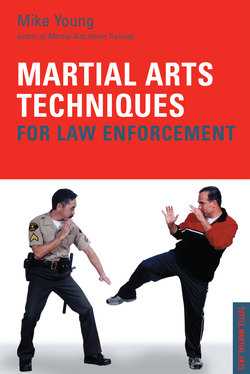Читать книгу Martial Arts Techniques for Law Enforcement - Mike Young - Страница 10
На сайте Литреса книга снята с продажи.
Оглавление1
Reasonable Force
Before we look at specific martial arts, we should first review and understand the underlying justifications for using physical force.
As law enforcement officers, we have a positive duty to use force when necessary to discharge our duty. Whether we use verbal commands, professional presence, control holds, pepper spray, personal weapons, or firearms is influenced by many factors. Which force option we choose depends on the particular circumstances of each situation, including our level of on-the-job experience, size and weight, physical ability, and personal confidence.
In some cases, verbal commands and professional presence are enough to control a violent or assaultive suspect. In other cases, we may not even have time to give verbal commands to the suspect, for example, if a suspect attacks as soon as we arrive on the scene.
In 1989 it was established that any evaluation of a police officer’s decision to use force must recognize that we are often forced to make split-second decisions in situations that are tense, uncertain, and rapidly changing. We need to base our critical decisions about the use of force on a similar “reasonable officer standard”—to be determined by the facts and circumstances of the overall situation confronting us.
These facts and circumstances include whether the suspect poses an immediate threat to us or others, the severity of the crime at hand, whether the suspect is actively resisting arrest or attempting to evade arrest by flight, and whether the circumstances are tense and rapidly evolving. The size, height, and weight of the suspect in relation to us can also determine the amount of force that can be “reasonably” used.
In the past, many law enforcement agencies used a “Force Continuum,” or “Use of Force Barometer,” which required an officer to carry out a series of gradual steps before he or she could advance to different levels of force.
In the unpredictable world faced by law enforcement, however, a calm and passive situation can change into a life-threatening one in an instant. We need a guide that enables us to move from one force option to another immediately—without following a slow progression of procedures.
Today, the Los Angeles County Sheriff’s Department uses a “Situational Use of Force Options Chart” as a guide to help its deputies make the right decisions when utilizing force on duty. Many other police agencies use a similar “Use of Force Barometer” or “Use of Force Options Chart.”
In the force option chart, we can see that an officer’s actions depend on legal constraints that include departmental policy as well as state, federal, and case law.
The situations that we may encounter in the field can be assigned to one of four different categories: the individuals we confront may be cooperative, resistive, assaultive, or life threatening. The force options that we can use depend on which of these categories an individual’s behavior falls into.
If the individual is cooperative, we can use our professional presence, nonverbal cues, or verbal commands; or we can control, search, or handcuff the individual.
If the individual is resistive, we can use a control hold, a firm grip, a defensive tactic, intermediate weapons control techniques, or pepper spray.
If the individual is assaultive, we have the option to use personal weapons (any natural body part, i.e., hands, feet, knees, elbows, etc.), carotid restraint, less lethal weapons, impact weapons, or a K-9.
In the last category, where the individual’s actions are life threatening or could cause great bodily injury, we have the option to use a firearm or strike a vital area with an impact weapon.
Remember that the force options chart is only a guide to the use of force on duty. This particular chart may agree with your department’s policy—many departments use different categories or call for different responses—but all officers should understand this concept: always ask yourself—before using force—whether your use of force will be considered objectively reasonable given the overall circumstances. Treat every situation where you may have to use force as if you were being videotaped for the nightly news. (Remember the Rodney King incident!)
Most of the martial arts techniques demonstrated in this book would be used to deal with an individual who is assaultive or is threatening your life or trying to cause you great bodily injury. Before using them, however, you should evaluate whether the force required is objectively reasonable given the specific circumstances.
